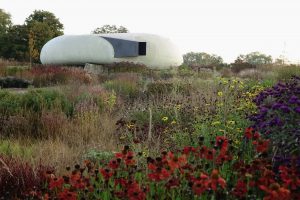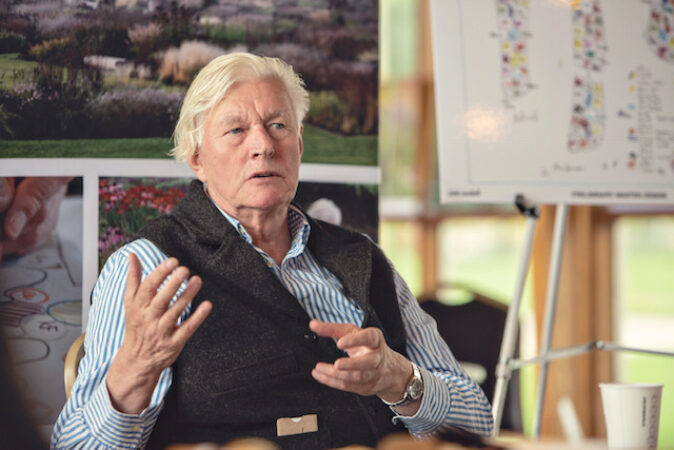Piet Oudolf is a garden designer. His projects include The High Line in New York City, Lurie Garden in Chicago, Toronto Botanical Gardens, and soon Belle Isle in Detroit. He launched his career with the establishment of his own garden at Hummelo in the Netherlands, where he still lives—and from where we spoke to him over telephone.
Piet Oudolf: You have to create an ideal of how you want to see the garden. It could be very romantic. It could be very natural. It could be sort of monocultural. It could be very contemporary. You can go all directions, but that is what you discover when you see the place where you start working. Where they want you to work. All the ideas come later when you have all the information, and then I think “Ok, that is what I have in mind, that’s what they think of me—what I could do here.” And then, of course, I interpret it myself towards my own ideas. First you need all the information to get started.
It could be woodland. It could be meadow. It could be a mix between the two. What we are talking about, Belle Isle, is more meadow like. A field of flowering plants and grasses will be interesting overall, through the years. That is what I have in mind there.
But even in that perspective, you can create different themes. People walk to a more flowery piece of the garden or into a grassier piece, with more grasses or more native plants. It could be a piece where it’s more organized. Within one space you can create several gardens that link to each other, in a harmonious way, but still are different.

Oudolf Garden Detroit, planting sketch
Detroitisit: Every time I go to the High Line it’s a completely different experience per year, as plants continue to grow, and they’re molded by the staff that’s there and nature. How do seasons influence your work?
PO: Seasonality is a big issue. I want you to enter in fall and have it feel like fall. In the spring, it should feel like spring. For every moment in time, or in the year, there are several aspects that remind you very strongly of the season you’re in. For example, in the spring we have more . . . that come out first before the plants emerge and then, of course, a young green from the plants come out, the first flowers, and then it grows into the summer with mostly flowering plants. Then into the fall where grasses splay, they grow because of the late flowering season. And the fall colors. Then the perennial plants or the flowering plants that go into decay in the seed, that becomes important. Even late in the winter, the skeletons of the plants play an important role.
PO: It feels like an image you’re in. Sort of a big picture. That’s what I try to realize. That it feels like a place right in time. The time of the season.
DII: When you work on a project, how often do you check in?
PO: It’s part of the contract normally. Usually once a year or every two years. It depends on what type of garden it is, the quality of the gardeners. Normally on the bigger projects they have very qualified gardeners. Sometimes it’s necessary to come in different seasons and then to evolve and access the garden together and see what happens and make changes, if necessary.
Like in the High Line, Chicago, and Atlantic Park, I come back every year. Or every second year. In different seasons.

Oudolf Private Garden, Netherlands
DII: And you’re pretty involved with the teams when you’re there.
PO: Yes, I think that’s most important. The client is important, but the most important side of the piece are the people who take care of the garden. That’s why we need quality. People need to know a lot about plants. They are maintaining, cleaning up and taking care of the garden—making sure the plants can grow naturally—that the plants can grow together, that the plants can grow into the future. This is what we assess for.
DII: Whenever I go to your gardens there is a feeling of complete immersion, a wholistic quality.
PO: It’s an experience for myself to be in it. I try to create a garden that has more than one layer, so that it’s not only trees or a plant here and there. You feel, when you’re in there, that it’s a world in itself. That is one of the main reasons people want to go there and, as you say, the changes in the seasons are very important. When you come today, it will be different than next week or even more different from a month ago. This is what intrigues you and makes you want to come back—you know it’s going to change, and you’re curious to see the changes. If you’re sensitive to it.
DII: It seems like a way for the garden to draw the nature out of you.
PO: Yes, I’ve thought about it. The gardens are an introduction to nature. People meet the gardens and they are interested in more than just the garden I do, they want to explore more gardens, nature. And sometimes people think the gardens are wild, and they are not at all. They are maintained. They behave well. It’s not really a wilderness, although they appear natural and wild.
You introduce people into another world.
DII: The spot you chose in Detroit—were you asked to work on Belle Isle in particular?
PO: Particularly on Belle Isle. They drove me around to see what I thought about the island. They said it’s an important part for the people of Detroit. They hang out under the tents. They said “Where do you think you would you like to do a garden?” And then we drove around, and we stopped at the Pavillion. There’s the botanical garden or conservatory. There’s the aquarium. That’s the right atmosphere. I couldn’t change my mind anymore.

Lurie Gardens, Chicago
DII: There was some notion of pulling out a cultural space that you tied between the conservancy and the other buildings.
The band shell, the pavilion—it’s a nice sort of place, a special place I feel people would love to go to. In fact, they already go there. It would be very nice if there was a garden that added—it makes it more complete, in my feeling.
DII: That ties it in beautifully. And then the fact that it looks at Canada.
PO: There are so many elements that come together there. This garden will only make it feel better and not so lost. Everything felt so lost there. The aquarium—maybe you know the feeling: you see the pavilion, beautiful building, and then the conservatory, beautiful by itself, but you also need a place where people would like to stay for a while. And that is the garden.
DII: The other day I was having a conversation with an architect about creating culture as opposed to just creating spaces to occupy. In many ways what you’re talking about is bringing in a sense of culture—not in an elitist way but in terms of an experience.
PO: Yes. Is there something wrong with that?
DII: No. That’s what we need. Detroit needs that.
PO: Everything, even a park, is a sign of culture. If you spend 500 million on a park or two million, the money comes from somewhere. You don’t put money in spaces that you want to lose.
DII: That’s a great point. Many of your projects attract a lot of attention, and you have a fanbase that’s global. This park will no doubt draw a lot of attention and, hopefully, opportunity for Detroit.
PO: I see my work as a small contribution to society. And to art—the art of gardening. And to culture.

Hauser & Wirth, perennial meadow Oudolf Field, London
DII: When you were in Detroit, did you spend a significant amount of time on the island? This is a place that people use everyday in specific ways—BBQing, swimming. When you’re planning your project, do you take those things into consideration? The ways in which the space is already being used.
PO: Yes. We drove it several times. We couldn’t see people swim—it was too cold—but what we did see gave us clear information about the use.
Also, it’s a sort of intuition—here should be, people do this, they watch the sunset here, this is where they picnic, this is where they bbq. You get a lot of information you can use with your intuition next to the fact that when you see the tower and the conservatory, you’re no longer lost because that is the place. This is where it should be.
You feel it should be there. The decision is made because you know the place is right.
This was for me the place to make a garden the size I normally do in a park. And this is it. I don’t think too much, to be honest.
DII: What’s the size of the garden?
PO: The footprint? I believe it is one and a half acres of perennial planting.
DII: There are a lot of volunteers—both novices and experts in gardening—from around the world, that are interested in coming in and helping. Specifically help plant and maintain? What part of the process would they be involved in?
PO: People come to look at the gardens. Let’s say in Europe, there are people who travel the world to tour our gardens. You also have people who want to volunteer in the gardens. And they are mostly from the city itself [Detroit]. And there are moments when we implement or plant the garden, people come from all over the country to help. Sometimes it feels like a sect [cult], but I don’t see myself as a sect leader.
People love gardens just like people love art. They travel a lot to see people make an installation or music—it’s true people go concerts all over the country.
DII: I know about five people who will be there helping plant.
PO: Yeah, they love to do this. And they do it voluntarily. And they’re happy to be part of an important project because they learn from it. It’s not that they don’t watch. They can learn.
DII: Do you have a core team that comes to plant with you?
PO: No, no. I’m only in charge of the design. In general, we have a local landscape architect. And they find a contractor. And the contractor finds the people who plant the garden.
DII: Tell us about the habits in your gardens? It seems where nature grows, animals come.
PO: Yes, I think that always happens if you make a garden that works as a community then it works as a habitat because I work with plants that are very close to the natural species. That is important—that plants are not overbred. Because we leave them in the winter, most of the winter, they provide seeds for birds. You see the sparrows hanging in the grasses. A lot of butterflies in the summer. Everything you want will come.
For me, it’s a natural process. It’s not intentional. The way I work and the plants I work with—they bring that naturally.
DII: I was talking to the woman who runs Lurie Gardens in Chicago about an entirely new, non-existing—
PO: A particular bird that came in. But also, you can imagine that, in cities like New York, it becomes a sort of migration area where in there is nothing and suddenly there is something so low and green and everything that is flying drops in, jumps in, because it’s a sort of habitat in the city. You can imagine. So many bees come back.
If you make gardens it comes by itself. If you make the right garden.
DII: What kind of feeling do you have, when you come in, simply as an observer of your gardens—of others and their experiences in your gardens? What do you feel when you walk through your spaces?
PO: I always feel good when I walk through my gardens. I never think “Oh how good I am for making this.” I just feel happy. It is part of my personality probably. Or I see it as part of my personality. I think it’s the same as when other people come in my gardens. Like adventure, being in another place. That is what I have in my own gardens.






















No comments
Sorry, the comment form is closed at this time.